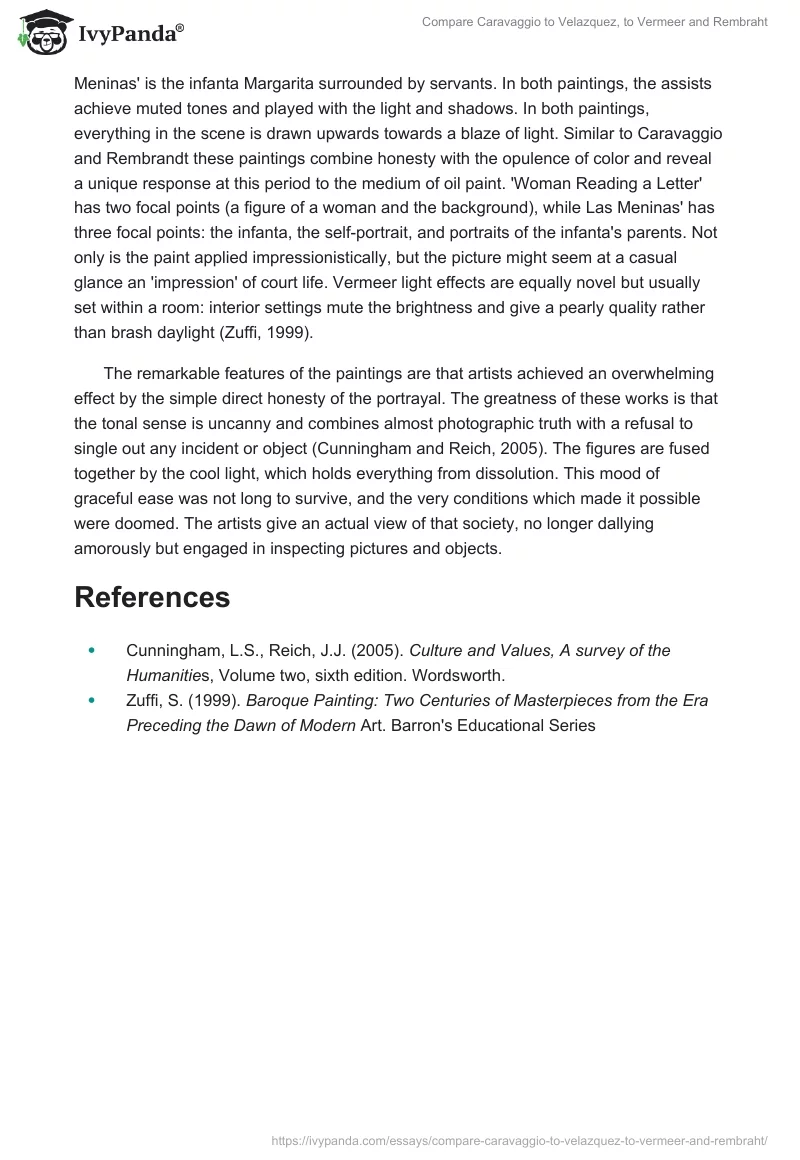In the mid-sixteenth century, a new mood had begun to make itself felt in all the arts. It is aimed at evoking from the spectator a more intense emotional response, at arousing feelings of rapture, devotion, or awe. There is in much painting of the era a new impression of limitless power, of figures bursting out of the frame of paintings. The very multiplicity of these artistic changes and the remarkable range they cover suggest that the source is to be found not in any sectarian or political change in the era, but rather in some fundamental upheaval in man’s concept of himself, a revolution of larger proportions, producing repercussions in all areas of human activity, whether religious, political, or aesthetic (Cunningham and Reich, 2005).
Caravaggio’s ‘The Calling of Saint Matthew’ (1599-1600) and Rembrandt’s ‘Night Watch’ (1642) have similar compositions and palettes. These paintings portray a group of people headed by men. In contrast to ‘Night Watch,’ ‘the Calling of Saint Matthew’ is based on the religious context. It is possible to distinguish two worlds in these paintings, foreground, and background. Caravaggio depicts Jesus’ bare feet underlining his divine nature and power. Rembrandt depicts that the Captain wears old-fashioned clothes. The painters posited an overall hierarchical order, harmoniously reflected in all its lesser parts. The disturbing intensity of these works contradicts any view of the ‘balanced’ nature. Color schemes have a stinging memorable individuality, and there is a tense feeling for personality in both works at once, ostentatious and complex, and gives some sense of complicated characters. ‘The Calling of Saint Matthew’ reflects certain dramatic feelings. The similarity is that Caravaggio and Rembrandt take scenes from ordinary surroundings, though never without the tremendous impact of Christ’s actions on ordinary men. A dispassionate intensity marks both works. The groups are painted with a bold tenderness; paint alters its consistency under Rembrandt’s demands, creating texture and tone as it is rubbed, scrubbed, or deeply clotted to make a patch of the amber-red sleeve, a crease of flesh, a thread of embroidery, or a jewel (Zuffi, 1999).
In contrast to these paintings, Velazquez’s ‘Las Meninas’ (1650) and Vermeer’s ‘Woman Reading a Letter’ (1662-1665) depict women characters: ‘Las Meninas’ depicts a family scene while ‘Woman Reading a Letter’ is a portrait. The main character of ‘Las Meninas’ is the infanta Margarita surrounded by servants. In both paintings, the assists achieve muted tones and played with the light and shadows. In both paintings, everything in the scene is drawn upwards towards a blaze of light. Similar to Caravaggio and Rembrandt these paintings combine honesty with the opulence of color and reveal a unique response at this period to the medium of oil paint. ‘Woman Reading a Letter’ has two focal points (a figure of a woman and the background), while Las Meninas’ has three focal points: the infanta, the self-portrait, and portraits of the infanta’s parents. Not only is the paint applied impressionistically, but the picture might seem at a casual glance an ‘impression’ of court life. Vermeer light effects are equally novel but usually set within a room: interior settings mute the brightness and give a pearly quality rather than brash daylight (Zuffi, 1999).
The remarkable features of the paintings are that artists achieved an overwhelming effect by the simple direct honesty of the portrayal. The greatness of these works is that the tonal sense is uncanny and combines almost photographic truth with a refusal to single out any incident or object (Cunningham and Reich, 2005). The figures are fused together by the cool light, which holds everything from dissolution. This mood of graceful ease was not long to survive, and the very conditions which made it possible were doomed. The artists give an actual view of that society, no longer dallying amorously but engaged in inspecting pictures and objects.
References
- Cunningham, L.S., Reich, J.J. (2005). Culture and Values, A survey of the Humanities, Volume two, sixth edition. Wordsworth.
- Zuffi, S. (1999). Baroque Painting: Two Centuries of Masterpieces from the Era Preceding the Dawn of Modern Art. Barron’s Educational Series


